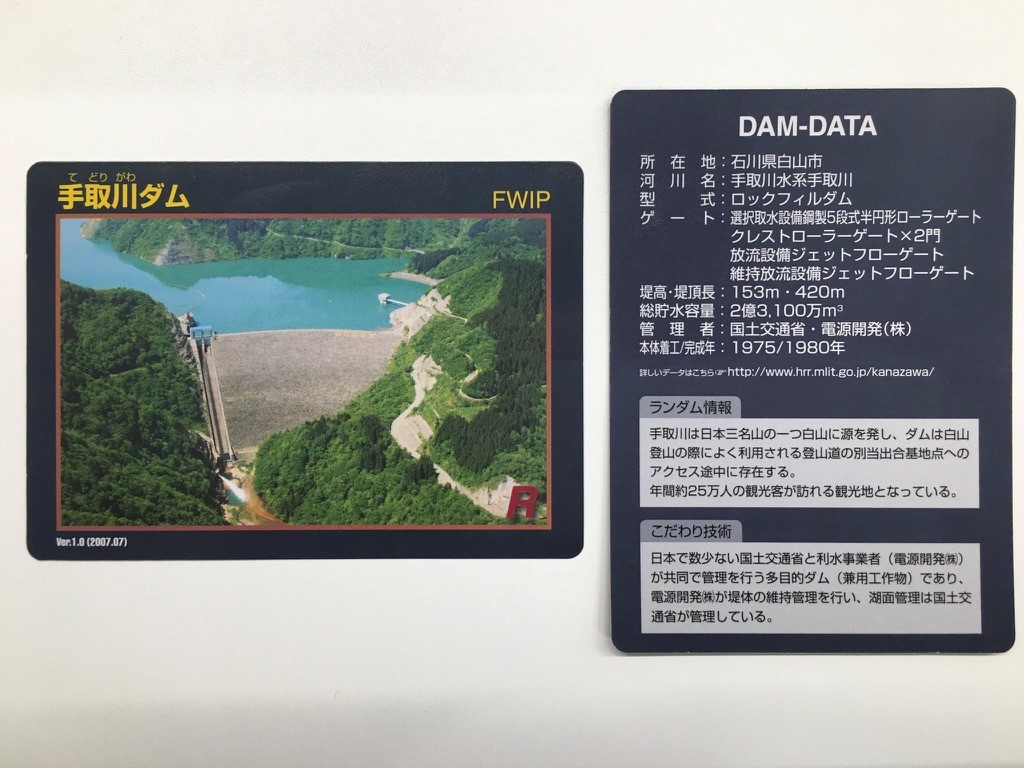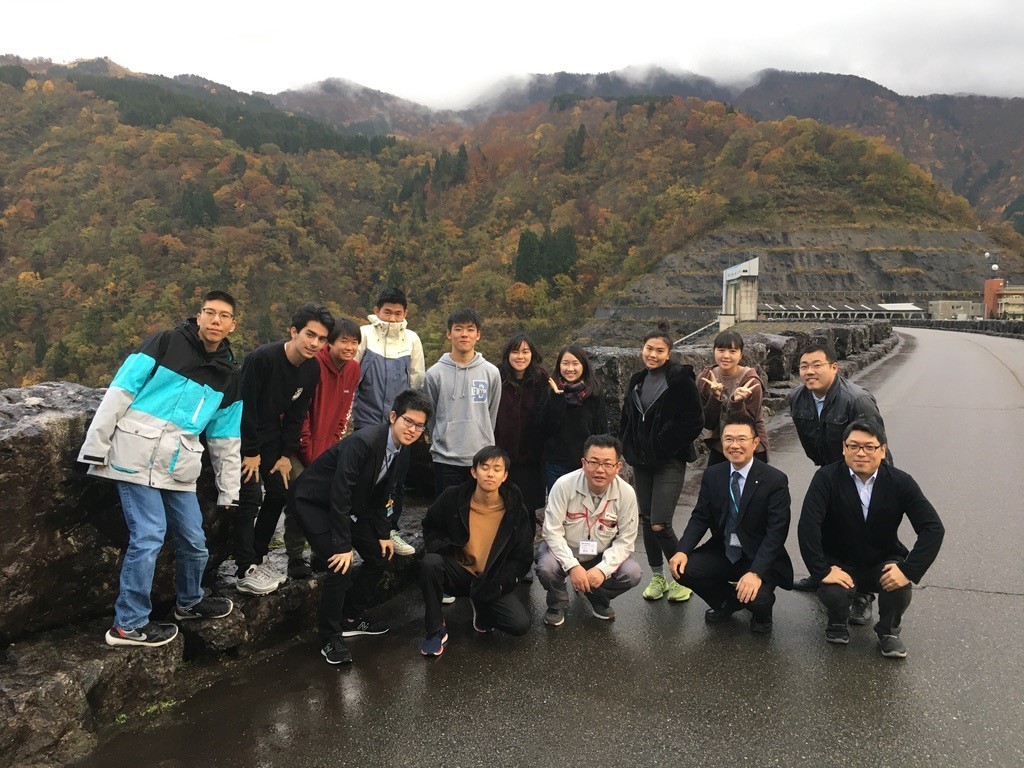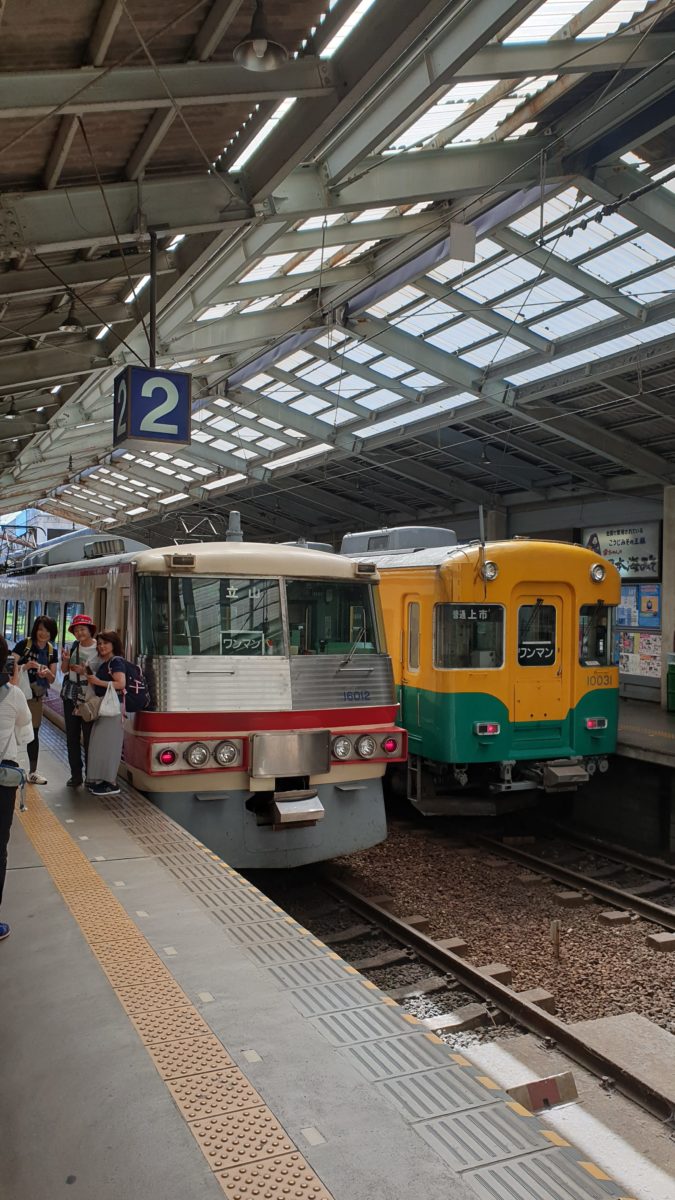Faculty
学科
 Hi everyone, its Ryan again! Today I’d like to talk about one of the highlights of November, the school’s Sports Festival (球技大会).
Hi everyone, its Ryan again! Today I’d like to talk about one of the highlights of November, the school’s Sports Festival (球技大会).
On 11/16, the S class students travelled down the mountain to compete with their classmates in the school’s annual Sports Festival. This year, the S1 and S2 students combined forces in badminton, basketball, and dodgeball to compete against the upperclassmen.
The S class teams faced tough opposition against bigger, stronger, and more experienced students, but they still fought hard. Their tenacity and enthusiasm were impressive, and the underclassmen were able to win many matches against their seniors. Ultimately, S class teams were able to secure 5th place in both the basketball and dodgeball tournaments.
Results aside, the festival was a good opportunity for the students to break up the monotony of their schoolwork while working together with their classmates. The students enjoyed their chance to get moving and test their skills while being supported and cheered on by their friends and cleverly took advantage of the nearby bookstore to purchase the latest volumes of their favorite manga and light novels.
In the end, the Sports Festival was a great experience for all the students. The only complaint that anyone seems to have is that they weren’t able to stop at McDonald’s on the way back!
Ryan J. Vicencio
やあ、みんな!ライアンだよ!今日は11月にあった球技大会のハイライトを紹介していきます。
11月16日、S科の学生が恒例の球技大会に出場するために山を下りました。今年はS1とS2の学生がひとつのチームとなってバドミントン、バスケットボール、ドッジボールの種目で先輩たちと対決しました。
S科が相対するチームは自分たちより身体が大きく、力が強く、経験値も勝る上級生たちでしたが、必死に食らいつきました。その粘り強さと根性は目を見張るものがあり、年下にもかかわらず先輩に勝利する試合がたくさんありました。結果的にS科はバスケットボールとドッジボールのトーナメントで5位に入賞することができました。
結果はさておき、球技大会のおかげで毎日の学業から離れて仲間と力を合わせる良い機会となりました。身体を動かして、友達に応援されつつ自分の力を試すことを楽しみました。また、ちゃっかり近くの本屋で好きな漫画の最新刊やライトノベルを購入する気転も見せました。
球技大会は全学生にとって素晴らしい体験となりました。唯一聞こえた文句は帰り道でマクドナルドに寄れなかったことです!
ライアン・J・ビセンシオ
 Hi everyone, its Ryan again! Today I’d like to talk about one of the highlights of November, the school’s Sports Festival (球技大会).
Hi everyone, its Ryan again! Today I’d like to talk about one of the highlights of November, the school’s Sports Festival (球技大会).
On 11/16, the S class students travelled down the mountain to compete with their classmates in the school’s annual Sports Festival. This year, the S1 and S2 students combined forces in badminton, basketball, and dodgeball to compete against the upperclassmen.
The S class teams faced tough opposition against bigger, stronger, and more experienced students, but they still fought hard. Their tenacity and enthusiasm were impressive, and the underclassmen were able to win many matches against their seniors. Ultimately, S class teams were able to secure 5th place in both the basketball and dodgeball tournaments.
Results aside, the festival was a good opportunity for the students to break up the monotony of their schoolwork while working together with their classmates. The students enjoyed their chance to get moving and test their skills while being supported and cheered on by their friends and cleverly took advantage of the nearby bookstore to purchase the latest volumes of their favorite manga and light novels.
In the end, the Sports Festival was a great experience for all the students. The only complaint that anyone seems to have is that they weren’t able to stop at McDonald’s on the way back!
Ryan J. Vicencio
やあ、みんな!ライアンだよ!今日は11月にあった球技大会のハイライトを紹介していきます。
11月16日、S科の学生が恒例の球技大会に出場するために山を下りました。今年はS1とS2の学生がひとつのチームとなってバドミントン、バスケットボール、ドッジボールの種目で先輩たちと対決しました。
S科が相対するチームは自分たちより身体が大きく、力が強く、経験値も勝る上級生たちでしたが、必死に食らいつきました。その粘り強さと根性は目を見張るものがあり、年下にもかかわらず先輩に勝利する試合がたくさんありました。結果的にS科はバスケットボールとドッジボールのトーナメントで5位に入賞することができました。
結果はさておき、球技大会のおかげで毎日の学業から離れて仲間と力を合わせる良い機会となりました。身体を動かして、友達に応援されつつ自分の力を試すことを楽しみました。また、ちゃっかり近くの本屋で好きな漫画の最新刊やライトノベルを購入する気転も見せました。
球技大会は全学生にとって素晴らしい体験となりました。唯一聞こえた文句は帰り道でマクドナルドに寄れなかったことです!
ライアン・J・ビセンシオ
 A few weeks ago, there was a soba festival here in Hakusan. At the festival, they had a variety of delicious local foods. There were many stands selling soba, beef, pork, takoyaki, melonpan, oysters, and even expensive Noto beef! I got to try deer meat for the first time in the form of a sausage!
A few weeks ago, there was a soba festival here in Hakusan. At the festival, they had a variety of delicious local foods. There were many stands selling soba, beef, pork, takoyaki, melonpan, oysters, and even expensive Noto beef! I got to try deer meat for the first time in the form of a sausage!
The ICT students were helping at the festival as well! The second year students worked on Saturday and the first year students worked on Sunday.
When I went on Sunday, I saw many of the students working hard at a variety of tasks, including guiding cars to vacant parking spaces and emptying and replacing the trash cans when full. It was quite refreshing to see the students in a different setting, as part of the local community! Many students seemed exhausted after the day of work and several told me that it was indeed very hard and tiring work.
I'm glad the students have the chance to participate in local community events and I look forward to seeing such interaction again in the future!
Anne Isobel Tan
今月の始め、ここ白山麓でそば祭りがありました。そば祭りでは地元の美味しい食べ物がたくさんありました。たくさんの露店が立ち並び、そば、牛肉、豚肉、たこ焼き、メロンパン、牡蠣、高級な能登牛まで!私はソーセージという形で、人生で初めて鹿肉を食べました!
国際高専の学生もお祭りを手伝っていました!土曜日は2年生、日曜日は1年生がボランティアをしました。私が行った日曜日は学生たちが駐車場の整理、ゴミ箱の入れ替えなど様々な業務をこなしており、普段とは違う地元のイベントを手伝う姿が見られて新鮮でした。大変な仕事だったようで、終わったあと疲れたと言っていました。
学生たちがボランティアする機会があってよかったです。これからも地元のイベントに参加する機会が増えることを願っています。
アン・イソベル・タン

 A few weeks ago, there was a soba festival here in Hakusan. At the festival, they had a variety of delicious local foods. There were many stands selling soba, beef, pork, takoyaki, melonpan, oysters, and even expensive Noto beef! I got to try deer meat for the first time in the form of a sausage!
A few weeks ago, there was a soba festival here in Hakusan. At the festival, they had a variety of delicious local foods. There were many stands selling soba, beef, pork, takoyaki, melonpan, oysters, and even expensive Noto beef! I got to try deer meat for the first time in the form of a sausage!
The ICT students were helping at the festival as well! The second year students worked on Saturday and the first year students worked on Sunday.
When I went on Sunday, I saw many of the students working hard at a variety of tasks, including guiding cars to vacant parking spaces and emptying and replacing the trash cans when full. It was quite refreshing to see the students in a different setting, as part of the local community! Many students seemed exhausted after the day of work and several told me that it was indeed very hard and tiring work.
I'm glad the students have the chance to participate in local community events and I look forward to seeing such interaction again in the future!
Anne Isobel Tan
今月の始め、ここ白山麓でそば祭りがありました。そば祭りでは地元の美味しい食べ物がたくさんありました。たくさんの露店が立ち並び、そば、牛肉、豚肉、たこ焼き、メロンパン、牡蠣、高級な能登牛まで!私はソーセージという形で、人生で初めて鹿肉を食べました!
国際高専の学生もお祭りを手伝っていました!土曜日は2年生、日曜日は1年生がボランティアをしました。私が行った日曜日は学生たちが駐車場の整理、ゴミ箱の入れ替えなど様々な業務をこなしており、普段とは違う地元のイベントを手伝う姿が見られて新鮮でした。大変な仕事だったようで、終わったあと疲れたと言っていました。
学生たちがボランティアする機会があってよかったです。これからも地元のイベントに参加する機会が増えることを願っています。
アン・イソベル・タン

 現在1年生が履修しているEngineering Context IBでは、エネルギーを題材にした授業が行われています。毎回様々な発電技術や各国のエネルギー政策を取り上げながら、技術には光と影があることを踏まえた技術者倫理を学生たちは学んでいます。
現在1年生が履修しているEngineering Context IBでは、エネルギーを題材にした授業が行われています。毎回様々な発電技術や各国のエネルギー政策を取り上げながら、技術には光と影があることを踏まえた技術者倫理を学生たちは学んでいます。
この授業の一環で、白山麓キャンパスの近くにあるJPower手取川第一発電所の見学を行いました。この見学会は今年で2回目ですが、年々バージョンアップされています。JPowerの田中所長から、最初にダムカードが配られ、ダムの分類と手取川ダムの特徴をわかりやすく解説して頂きました。手取川ダムは日本で4番目のロックフィル型ダムで、運転開始から40年、水力発電のみならず洪水調整、上水道用水、工業用水など様々な役割を担っています。1時間ほどの講義の後、ダムの上部に移動し、巨大なダムの迫力を体感しました。気温が低く小雨が降る生憎の天気でしたが、美しい紅葉に彩られた手取湖を眺めながら、ユーモア溢れる田中所長のお話を楽しく聴講することができました。
山崎俊太郎
In the first-year student's "Engineering Context IB" class, we are currently studying about energy. Each class we pick up various power generation technology and different countries' energy policies, and discuss the good and bad of technological advancement from an ethical stand point.
Recently, we took a trip to the JPower Tedori River Dam 1 near the Hakusanroku campus. This was our second visit to the dam. However, it is evolving each year. First, Mr. Tanaka, the chief manager of JPower, distributed dam cards and gave a lecture about different types of dams and the characteristics of Tedori River Dam. Tedori River Dam is the fourth rock-fill dam in Japan and has served not only as a water-power generator, but also as adjustment for floods, and provider for waterworks and construction water. After the lecture, we moved to the top of the huge dam to see the spectacular view. Sadly, it was chilly and drizzling, but we enjoyed the beautiful panorama of Tedori Lake decorated with colored autumn mountains as we listened to Mr. Tanaka's humorous explanation.
Shuntaro Yamazaki
 現在1年生が履修しているEngineering Context IBでは、エネルギーを題材にした授業が行われています。毎回様々な発電技術や各国のエネルギー政策を取り上げながら、技術には光と影があることを踏まえた技術者倫理を学生たちは学んでいます。
現在1年生が履修しているEngineering Context IBでは、エネルギーを題材にした授業が行われています。毎回様々な発電技術や各国のエネルギー政策を取り上げながら、技術には光と影があることを踏まえた技術者倫理を学生たちは学んでいます。
この授業の一環で、白山麓キャンパスの近くにあるJPower手取川第一発電所の見学を行いました。この見学会は今年で2回目ですが、年々バージョンアップされています。JPowerの田中所長から、最初にダムカードが配られ、ダムの分類と手取川ダムの特徴をわかりやすく解説して頂きました。手取川ダムは日本で4番目のロックフィル型ダムで、運転開始から40年、水力発電のみならず洪水調整、上水道用水、工業用水など様々な役割を担っています。1時間ほどの講義の後、ダムの上部に移動し、巨大なダムの迫力を体感しました。気温が低く小雨が降る生憎の天気でしたが、美しい紅葉に彩られた手取湖を眺めながら、ユーモア溢れる田中所長のお話を楽しく聴講することができました。
山崎俊太郎
In the first-year student's "Engineering Context IB" class, we are currently studying about energy. Each class we pick up various power generation technology and different countries' energy policies, and discuss the good and bad of technological advancement from an ethical stand point.
Recently, we took a trip to the JPower Tedori River Dam 1 near the Hakusanroku campus. This was our second visit to the dam. However, it is evolving each year. First, Mr. Tanaka, the chief manager of JPower, distributed dam cards and gave a lecture about different types of dams and the characteristics of Tedori River Dam. Tedori River Dam is the fourth rock-fill dam in Japan and has served not only as a water-power generator, but also as adjustment for floods, and provider for waterworks and construction water. After the lecture, we moved to the top of the huge dam to see the spectacular view. Sadly, it was chilly and drizzling, but we enjoyed the beautiful panorama of Tedori Lake decorated with colored autumn mountains as we listened to Mr. Tanaka's humorous explanation.
Shuntaro Yamazaki
 Hello everyone, in my free time I like to travel to famous sightseeing spots in the area around Hakusanroku. A little while ago I went and traveled the Tateyama-Kurobe Alpine route. It is accessible from Toyama station (about 30 minutes by shinkansen from Kanazawa Station), and is a series of trains, busses and cable cars that takes you from Toyama, up to Mt. Tateyama, across to the Kurobe Dam, and finally down into Nagano. The whole crossing takes 9-12 hours one-way, but is well worth the time. As we move into winter there is a famous “snow corridor” (Yuki-no-otani) that you can walk through that looks like a canyon cut out of the snow! Why not visit it sometime?
Hello everyone, in my free time I like to travel to famous sightseeing spots in the area around Hakusanroku. A little while ago I went and traveled the Tateyama-Kurobe Alpine route. It is accessible from Toyama station (about 30 minutes by shinkansen from Kanazawa Station), and is a series of trains, busses and cable cars that takes you from Toyama, up to Mt. Tateyama, across to the Kurobe Dam, and finally down into Nagano. The whole crossing takes 9-12 hours one-way, but is well worth the time. As we move into winter there is a famous “snow corridor” (Yuki-no-otani) that you can walk through that looks like a canyon cut out of the snow! Why not visit it sometime?
Davis Evans
皆さん、こんにちは。私は休日を利用して白山麓近辺の有名な観光地を旅行するのが好きです。少し前になりますが、立山黒部アルペンルートへ足を運びました。富山駅(金沢駅から新幹線で約30分)からスタートし、電車、バス、ケーブルカーを乗り継いで立山を登り、黒部ダムを渡って、長野まで下るルートです。片道9~12時間くらいかかりますが、それだけの時間をかけてでも行く価値があります。冬に入りますとあの有名な雪の大谷を通ることができます。行ってみてはいかがでしょうか。
デイビス・エバンス
 Hello everyone, in my free time I like to travel to famous sightseeing spots in the area around Hakusanroku. A little while ago I went and traveled the Tateyama-Kurobe Alpine route. It is accessible from Toyama station (about 30 minutes by shinkansen from Kanazawa Station), and is a series of trains, busses and cable cars that takes you from Toyama, up to Mt. Tateyama, across to the Kurobe Dam, and finally down into Nagano. The whole crossing takes 9-12 hours one-way, but is well worth the time. As we move into winter there is a famous “snow corridor” (Yuki-no-otani) that you can walk through that looks like a canyon cut out of the snow! Why not visit it sometime?
Hello everyone, in my free time I like to travel to famous sightseeing spots in the area around Hakusanroku. A little while ago I went and traveled the Tateyama-Kurobe Alpine route. It is accessible from Toyama station (about 30 minutes by shinkansen from Kanazawa Station), and is a series of trains, busses and cable cars that takes you from Toyama, up to Mt. Tateyama, across to the Kurobe Dam, and finally down into Nagano. The whole crossing takes 9-12 hours one-way, but is well worth the time. As we move into winter there is a famous “snow corridor” (Yuki-no-otani) that you can walk through that looks like a canyon cut out of the snow! Why not visit it sometime?
Davis Evans
皆さん、こんにちは。私は休日を利用して白山麓近辺の有名な観光地を旅行するのが好きです。少し前になりますが、立山黒部アルペンルートへ足を運びました。富山駅(金沢駅から新幹線で約30分)からスタートし、電車、バス、ケーブルカーを乗り継いで立山を登り、黒部ダムを渡って、長野まで下るルートです。片道9~12時間くらいかかりますが、それだけの時間をかけてでも行く価値があります。冬に入りますとあの有名な雪の大谷を通ることができます。行ってみてはいかがでしょうか。
デイビス・エバンス
 高専祭の開催やその詳細などいくつかの話題はすでにホームページ等にて紹介されていますが、改めて今年度は[Connect]をテーマに、高専・工大がキャンパスを共有して行われました。テーマに沿ったかのように、学科、学年、部活などの垣根を超えた[Connect]が多くの場面で見られました。その中で、学校と保護者の[Connect]が力強く見られたのが、高専祭名物の「お餅つき」です。日曜日のみの1日限定での開催となりますが、長蛇の列が並ぶほどの人気を毎年みせ、数時間で300個から400個の売り上げを出しました。このお餅つきは日本の食文化に繋がる伝統行事であり、国際色豊かな本校でもこういった日本の文化を大事にしていければと思います。また、技術の発展で、機械でついたお餅も十分においしいかとは思いますが、昔ながらの「気持ち」と「力」のこもったつきたてのお餅は格別のおいしさだったと思います。
高専祭の開催やその詳細などいくつかの話題はすでにホームページ等にて紹介されていますが、改めて今年度は[Connect]をテーマに、高専・工大がキャンパスを共有して行われました。テーマに沿ったかのように、学科、学年、部活などの垣根を超えた[Connect]が多くの場面で見られました。その中で、学校と保護者の[Connect]が力強く見られたのが、高専祭名物の「お餅つき」です。日曜日のみの1日限定での開催となりますが、長蛇の列が並ぶほどの人気を毎年みせ、数時間で300個から400個の売り上げを出しました。このお餅つきは日本の食文化に繋がる伝統行事であり、国際色豊かな本校でもこういった日本の文化を大事にしていければと思います。また、技術の発展で、機械でついたお餅も十分においしいかとは思いますが、昔ながらの「気持ち」と「力」のこもったつきたてのお餅は格別のおいしさだったと思います。
前日からもち米の下準備を用意した役員の皆さん、当日は早朝より参加し2キロもある杵を何百回も振りかざしたお父様方、あんこと黄粉で絶妙の味を引き出したお母様方、また杵や臼等を貸してくださった教職員の方々、ありがとうございました。
津田 明洋
There are already some articles about the "Kosensai" on the website, but I would like to talk some more about our school festival. This year's Kosensai was subtitled "Connect" and was a collaboration between ICT and KIT. As if to fulfil this theme, there were sites of connection between various departments, ages, and clubs. One good example of a strong connection between the school and guardians is the annual "mochi-tsuki (sticky rice pounding)." It was only held on Sunday. However, it was so popular that there was a long line to buy the mochi, which we sold about 300 to 400 packages in a few hours. "Mochi-tsuki" is a Japanese tradition and I hope ICT will continue to cherish local Japanese cultures like this even as we transform into an international community. Also, technological advancements make automated mochi pounding possible, but I believe the mochi we made with our hearts and hands tasted much better and special.
I would like to thank the staff who prepared the rice, the fathers who pounded the rice several hundred times from early morning, the mothers who flavored the mochi with anko and kinako, and the teachers who lent us the hammer and mortar. Thank you so much.
Akihiro Tsuda

 高専祭の開催やその詳細などいくつかの話題はすでにホームページ等にて紹介されていますが、改めて今年度は[Connect]をテーマに、高専・工大がキャンパスを共有して行われました。テーマに沿ったかのように、学科、学年、部活などの垣根を超えた[Connect]が多くの場面で見られました。その中で、学校と保護者の[Connect]が力強く見られたのが、高専祭名物の「お餅つき」です。日曜日のみの1日限定での開催となりますが、長蛇の列が並ぶほどの人気を毎年みせ、数時間で300個から400個の売り上げを出しました。このお餅つきは日本の食文化に繋がる伝統行事であり、国際色豊かな本校でもこういった日本の文化を大事にしていければと思います。また、技術の発展で、機械でついたお餅も十分においしいかとは思いますが、昔ながらの「気持ち」と「力」のこもったつきたてのお餅は格別のおいしさだったと思います。
高専祭の開催やその詳細などいくつかの話題はすでにホームページ等にて紹介されていますが、改めて今年度は[Connect]をテーマに、高専・工大がキャンパスを共有して行われました。テーマに沿ったかのように、学科、学年、部活などの垣根を超えた[Connect]が多くの場面で見られました。その中で、学校と保護者の[Connect]が力強く見られたのが、高専祭名物の「お餅つき」です。日曜日のみの1日限定での開催となりますが、長蛇の列が並ぶほどの人気を毎年みせ、数時間で300個から400個の売り上げを出しました。このお餅つきは日本の食文化に繋がる伝統行事であり、国際色豊かな本校でもこういった日本の文化を大事にしていければと思います。また、技術の発展で、機械でついたお餅も十分においしいかとは思いますが、昔ながらの「気持ち」と「力」のこもったつきたてのお餅は格別のおいしさだったと思います。
前日からもち米の下準備を用意した役員の皆さん、当日は早朝より参加し2キロもある杵を何百回も振りかざしたお父様方、あんこと黄粉で絶妙の味を引き出したお母様方、また杵や臼等を貸してくださった教職員の方々、ありがとうございました。
津田 明洋
There are already some articles about the "Kosensai" on the website, but I would like to talk some more about our school festival. This year's Kosensai was subtitled "Connect" and was a collaboration between ICT and KIT. As if to fulfil this theme, there were sites of connection between various departments, ages, and clubs. One good example of a strong connection between the school and guardians is the annual "mochi-tsuki (sticky rice pounding)." It was only held on Sunday. However, it was so popular that there was a long line to buy the mochi, which we sold about 300 to 400 packages in a few hours. "Mochi-tsuki" is a Japanese tradition and I hope ICT will continue to cherish local Japanese cultures like this even as we transform into an international community. Also, technological advancements make automated mochi pounding possible, but I believe the mochi we made with our hearts and hands tasted much better and special.
I would like to thank the staff who prepared the rice, the fathers who pounded the rice several hundred times from early morning, the mothers who flavored the mochi with anko and kinako, and the teachers who lent us the hammer and mortar. Thank you so much.
Akihiro Tsuda

































